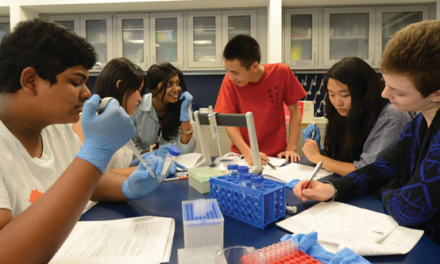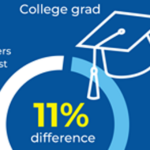Anne Hyslop, director of policy development at All4Ed, shares some perspectives on what may be ahead for ESSA and its accountability measures after the pandemic.
We will be analyzing the pandemic’s impact on K-12 education for years. One indicator of that impact is the 2022 National Assessment of Educational Progress (NAEP) reading and math scores for 4th graders, which significantly declined from pre-pandemic scores. Other data on student academic growth might be harder to find because the accountability requirements of the Every Student Succeeds Act (ESSA) were paused during the pandemic. The U.S. Department of Education granted states flexibility on required ESSA testing during the 2020-21 and 2021-22 school years.
This fall marks the return of the requirements. We asked Anne Hyslop for some perspective on what may be ahead for ESSA and its accountability measures. Hyslop is the director of policy development at All4Ed, a nonprofit advocacy organization committed to expanding equitable educational opportunities for students of color and students from low-income families and other marginalized groups. Before that, Hyslop worked for the U.S. Department of Education during the final two years of the Barack Obama administration, as ESSA was being debated in Congress, and as it was enacted and implemented. “At the department, I worked on some of the earliest regulations and guidance pertaining to ESSA implementation,” says Hyslop. “My focus was on Title I, so I did a lot of work on assessments and accountability.”
Kappan spoke with Hyslop about ESSA school improvement plans after the pandemic, the recent NAEP scores, and the possible fates of accountability.
Phi Delta Kappan: How is accountability under ESSA different from NCLB?

Anne Hyslop
Hyslop: ESSA marked a real shift in federal policy around accountability from what we had seen under No Child Left Behind. There was a recognition that some of the provisions in NCLB weren’t working anymore. They were too rigid, and they were too limited. We had come a long way since 2001, and we had more data available to help us think about how students were doing in the classroom and out of the classroom than we did when NCLB was first being discussed. This notion that the only measures we should consider in accountability systems were achievement and graduation rates seemed a little outdated. We had college- and career-readiness data, and we had better data on student growth and change from year to year. Many states had started to incorporate those measures into their accountability systems. It was time for the federal law to catch up and recognize that a multiple-measure system was a better way to evaluate how schools were preparing students.
There also was recognition that some of the options required when schools were identified for support just didn’t make sense. NCLB laid out this very rigid and prescribed set of procedures: “In Year Two, this happens. And then in Year Three, you go to this, and in Year Four, it’s this.” Those systems weren’t especially effective at helping schools improve and didn’t allow for differences in local context or local needs. There was a push to create school improvement structures that were more flexible.
One of the hardest and probably least popular things among districts was that under NCLB when its schools were identified for improvement, a portion of the district’s Title I funds were only to be used for specific school improvement activities, like school choice and tutoring. ESSA got rid of those restrictions. With ESSA, when a school is identified, you need to have a school improvement plan, but it’s up to the individual school and district and, in some cases, the state, to determine what interventions make sense so long as they are evidence-based and likely to work with that population of students and in that particular context.
There was a recognition that we need more flexibility on the school improvement side of things. We had gotten to a place, particularly before Secretary (Arne) Duncan announced the policy of NCLB waivers, where a lot of schools were being identified (as needing improvement) under NCLB because of its goal of 100% of students needing to be proficient in reading and math by 2014. Obviously, that was a harder and harder goal to reach, and more and more schools were not making it. You ended up having large portfolios of schools that were technically needing improvement — far more than what states or districts could reasonably support. The idea was: How can we right-size the system to get a portfolio of schools needing improvement that was a little bit easier to manage while also maintaining some of the things about NCLB that folks liked? Can we limit whole-school improvement to the bottom 5% of schools in the state? We wanted to keep that focus a little tighter on the schools that especially need help. And that was different from NCLB, which didn’t have relativistic thinking about 5% or 10% of schools. Any school that didn’t meet the goals was identified (as needing improvement).
There are other smaller changes, but to me, those are the biggest ones. ESSA moved away from the limited swath of measures that are considered to allow for broader measures; it had a lot more flexibility on the school improvement side, with a lot less rigidity around how funding is spent; and it had different ways of thinking about which schools should be identified and creating a more manageable pool of schools.
Kappan: What does the accountability landscape look like since the pandemic?
Hyslop: I think a lot of people would probably be surprised that ESSA has been the law of the land for seven years. It still feels like it’s a new law, and I think in part that’s because of the pandemic coming along and shifting everyone’s focus. The new education law was no longer top of mind. Instead, it was how can we make sure students are fed? How can we keep students learning? How can we keep students safe? It shifted everyone’s focus, and rightly so.
States took several years to develop their new plans under ESSA. This is true with any big shift in federal law — it takes several years to implement it. States were just beginning to implement their ESSA plans. A lot of states didn’t even identify schools for support under their new accountability systems until the 2017-18 or 2018-19 school years. So even though ESSA was passed in 2015, you had a lag.
The systems were quite new, and then the pandemic hit. Schools shut down. We weren’t administering our state assessments. There was no way to keep accountability systems and structures up and running. It was not feasible at the time, so we put everything on ice. A big pause. If you were a school in improvement before the pandemic, you’re going to stay in improvement, but we’re not going to ask states to identify new schools. They didn’t even have the data they would need to do that. That shouldn’t be their focus. They need to focus on maintaining stable learning environments for students. The pandemic shifted everybody’s focus.
We are just now getting back in 2022 to restarting some of these ESSA accountability systems, but with some flexibility and changes.
We are just now getting back in 2022 to restarting some of these ESSA accountability systems, but with some flexibility and changes. We are in an interesting time for accountability. We don’t know what the future holds. We can look to what we know was true before the pandemic, but I don’t think those lessons are going to hold now. What we saw before the pandemic was a mixed bag. States had been given a lot of flexibility in terms of designing their accountability system under ESSA, and they took advantage of that flexibility. All4Ed did an analysis that was released in 2020 that showed there were some states where less than 5% of schools were identified for improvement. In other states, it was 60%. It was a huge variation. Some states made different choices because that’s what ESSA enabled them to do. That was the gamble of being flexible. We could see the same thing again coming out of the pandemic, with a lot of variety in terms of where states’ accountability systems land.
NCLB’s accountability system was a huge focus. Everyone was talking about it: Which schools were in improvement, which schools weren’t. Lists of schools were written up in the newspaper every year — you don’t see that as much now. Accountability is not the driving reform policy lever that state education leaders or district superintendents are focusing on. The accountability systems are operating in the background quietly. They are more subtle. Some states issue A through F grades, and there might be parents who say, “Oh my child attends a B school,” but a lot of states don’t do that. Parents have no idea that their child attends a school that was identified for comprehensive or targeted support under ESSA. It’s just not prominently displayed anywhere. There’s not the same fuss and attention placed on it as there was before. It doesn’t mean that the school doesn’t have an improvement plan and isn’t working to make changes to better support students. It’s just quieter reform.
Kappan: What happened to ESSA’s accountability requirements during the pandemic?
Hyslop: All throughout the pandemic, even as Secretary (Betsy) DeVos and now Secretary (Miguel) Cardona had waived certain accountability requirements under ESSA, they always maintained that schools identified before the pandemic as needing supports still need supports, and states need to be providing those supports. Obviously, you might have to provide interventions in different ways. You might look at the data and see that different things need to happen, but those schools still need to be receiving services.
The way school improvement funding works under ESSA is that each year, states set aside 7% of their Title I allocation, and that money must go to schools that are identified for support under ESSA. Those funds still existed throughout the pandemic, and states were still distributing them to districts with identified schools. Those improvement plans should have been happening. Whether in every single case, they were implementing that plan with the same rigor and attention as they were before March 2020 is questionable, but they still were in support.
The guidance the Department of Education has issued following this accountability freeze has said, “Think differently about those schools that have been doing the work over the last five years. Are they ready to exit improvement status? Have student outcomes improved sufficiently that you feel they don’t need to be supported anymore?” That wasn’t the case during the pandemic. The only schools that could exit improvement status during the pandemic pause were schools that had been identified due to graduation rates being below 67%, which was a metric that was unaffected by the pandemic because graduation rates could still be measured during the pandemic, unlike assessments which were paused. Even in 2020 and 2021, if you were a high school whose graduation rate had been 60% but now was 70%, you could’ve exited improvement status. All the other schools were held in place. This fall is the first time they will have a chance to exit based on their performance from last year and other data.
What’s going to happen to the schools that were identified before the pandemic? Do they exit? Do they stay in improvement? States are doing different things to identify schools now than they were before COVID. They might be looking at different measures and may have changed their methodologies a little bit to account for the fact that we had some gaps in data due to not giving state assessments in 2020. The Education Department recognizes this. They issued guidance finalized last winter that recognized states might need to make a one-year change to their accountability systems because of the gap in data or because COVID quarantine isolation policies required them to change the way they measure chronic absenteeism. States had the chance to come in and say how they’re modifying their indicators for fall 2022. You see a lot of states saying they’re going to be looking at 2018-19 data and 2020-21 data and determine which schools need support and which schools have made progress. Or they’ve changed their definition of chronic absenteeism. Those changes are intended to be temporary. This is not necessarily how the state will measure chronic absenteeism forever, but it’s what makes sense right now given the unique context we are in.
Kappan: NAEP reading and math scores for 4th graders significantly declined. Could you talk about that?
Hyslop: I’m not going to sugarcoat the results. They were very disappointing and really troubling to see. It should be a real wake-up call that we need to do more to support students. Students were deeply affected by the disruptions that the pandemic brought.
It’s a snapshot in time. I’m not necessarily saying that these results will be the same five years from now, but for this group of students who were in K-12 schools during the pandemic, what can we do to support them, accelerate their learning, and help them catch up? I wouldn’t necessarily agree with the narrative that the pandemic wiped out 20 years of learning, but I do think this is a moment for everybody to come together and support students.
Look at some of the responses states and districts have had to COVID and some of the things that they’re doing with their COVID relief funds. They have voluntary tutoring. Maybe it shouldn’t be voluntary. Maybe every student needs this. A lot of students lost significant instructional time, hours in the classroom. How are you going to make up that time? Are you doing summer schooling? Are you rebalancing your calendar? It’s a call for educational leaders to think, “Are our plans for student recovery post-COVID ambitious enough? Are they big enough? Long term enough? How can we sustain this?” It’s hard to see the NAEP data and not realize how deeply students were affected, particularly students with disabilities and students of color. The top-level data is hard enough to look at, but when you look at how particular groups of students have fared, it’s even more urgent to think about large-scale supports, not just a little bit here and there, but something that’s going to be up to the task that we have.
The pandemic, I hope, was a once-in-my-lifetime event. I hope we will keep tracking the cohorts of students that were in school during the pandemic. Think about 4th graders five years from now who were in early childhood and prekindergarten during the pandemic. I’m sure they were affected, but their academic learning was probably not as affected as students who were in elementary school learning how to read and doing math via Zoom. I hope that we’ll see some bounce back in a few years. Still, that doesn’t keep us from needing to really focus on this generation of students and what we can do to support them long term so that these declines don’t become permanent and follow them throughout their lives.
Kappan: How can accountability under ESSA help underserved students and their families in the school improvement process?
Hyslop: One of the most important things that ESSA retained from NCLB was the focus on individual groups of students. It is not just looking at school performance as a whole but also, for example, looking at graduation rates for Black students and college- and career-readiness rates for Latinx students. Schools are identified in some cases because one or two groups of students are really struggling and not getting the support they need.
The first step is identification, but identification doesn’t lead to improvement — just being on a list somewhere does nothing for students. What really matters is the response. The school improvement apparatus that states and districts have is important. One of the first things states and districts must do when schools are identified is sit down and do a needs assessment. They look not just at the accountability data, but they look at all sorts of data about students in that school to come up with a plan. They might see that students are struggling in math but not in reading. Or vice versa. They then go much deeper, maybe even classroom to classroom, talking to people in the community about what may be needed. These plans are supposed to be developed collaboratively, not just top-down, but thinking about educators and families and having community engagement around them. Ideally, those plans will result in real changes that would be felt by students. It might mean hiring an extra reading specialist, getting a new math curriculum, putting in place a new social-emotional learning curriculum, or setting up college counseling. It could mean hiring different people or hiring new people. That’s where that 7% set-aside for schools identified under ESSA would come in, and they would get some additional money to help them implement this plan.
There’s not enough money to go around. One of the things that All4Ed has been advocating for is to increase money for school improvement to be sure that all schools have the extra resources they need to do a comprehensive school improvement plan, so they are able to support all the things they need to do, including staffing and counseling and wraparound services. Those are changes that students would feel. Families would see things being different at their school and see additional resources coming in that they didn’t have before. Where accountability programs really touch students and families is on the school improvement response side.
And granted, there’s no silver bullet for school improvement. It certainly has not always worked in every case. There are a lot of stories of schools continuing to be identified as needing support and reform after reform is not working. It’s not about how the school improves itself, but about how district or state support teams can be part of the process to provide technical assistance and other resources to help those school leaders implement improvement plans, monitor progress along the way, and make course corrections when things are not working.
Kappan: What do you see happening in five years? Ten years?
Hyslop: Maybe ESSA will be reauthorized. I don’t know. It took so long to get NCLB reauthorized, so we might be talking about a different federal law, but ESSA may also be with us for a while. I hope that we still have accountability systems in place — that we still are focusing on different groups of students, but we have even better, even richer data than we do now. There are a lot of things that states can do to improve their data and be thinking about measures in different ways so that we’re getting a fuller picture than we have now of schools.
There are a lot of things that states can do to improve their data and be thinking about measures in different ways so that we’re getting a fuller picture than we have now of schools.
I hope we have even more robust systems than we do now for school improvement. When you think about federal policy, most federal money goes to districts and schools not based on academics at all. It’s money to support students with disabilities, money to support English learners, money to support students from low-income families, and so on. The school improvement money is some of the only federal money that goes to districts and schools based on student learning outcomes. Especially with the pandemic and the disruptions that we’ve seen, we need to put more money into school improvement and build up that side of the accountability coin. The identification of schools and the indicators was the focus after ESSA was passed. There was less focus on what you do once a school is identified. I would hope to see that improvement piece built out, get more attention and more funding, and become more robust, so there is a better library of evidence-based interventions and so we can know more about what works and what doesn’t work than we do now. That’s my hopeful take on what happens.
I think there’s also a real possibility, though, that accountability continues to wither away. It continues to operate in the background. Maybe there still would be schools that are identified for support. States are running these systems, but it’s not used as a tool to target resources to students. It’s functioning on the books but not really the focus. I think that would be a missed opportunity. We will see which way we go.
We’re just now starting this post-pandemic accountability world. This will be the first time many states have identified schools since 2017-18; they haven’t done it in five years. It’s really a restart in a lot of ways. Part of how things go will depend on the federal landscape. Do Democrats stay in control? Does President Joe Biden have a second term? You can’t predict many things federally. That’s also true at the state level. Who are our state education leaders? Where does that go? I could see it going in a lot of different directions. I hope we don’t forget about accountability being a tool that can help support student learning, especially because it is one of the only ones ESSA is distinctly focused on.
The challenges are bigger than ever. We are coming out of the pandemic and two years of disrupted learning for millions of students. We should be redoubling our focus on this and not turning away. I would hope that folks could also see how the accountability systems and some of the school improvement resources funding and structures that are in place could be used to sustain some of the COVID relief efforts, too. The COVID relief funding in the American Rescue Plan will not be around forever. However, ESSA is here to stay. There will be Title I funding for the foreseeable future. This could be a way to help sustain some of those COVID relief efforts that are focused on supporting student learning. It may not be the way that you support your infrastructure upgrades, but it would work for your tutoring programs or for your early reading interventions.
This article appears in the November 2022 issue of Kappan, Vol. 104, No. 3, pp. 30-35.
ABOUT THE AUTHOR

Kathleen Vail
Kathleen Vail is managing editor of Kappan magazine.
Visit their website at: https://pdkintl.org/










